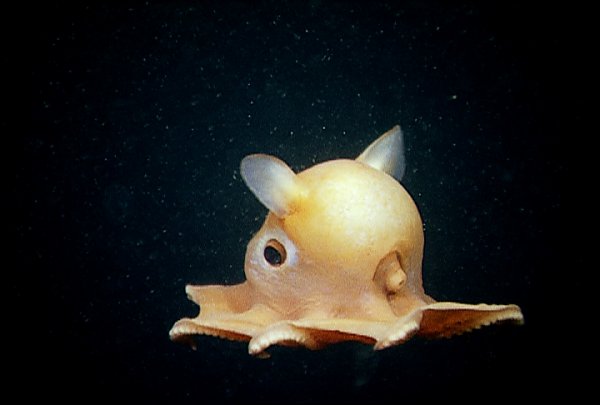If you are lucky enough to participate in an expedition deep under the ocean and you suddenly come across a small bell-shaped octopus only 1 inch long, pale in color, with ears and short tentacles, While swimming in the water, you have met a Dumbo octopus – the cutest marine animal in the world.

Dumbo octopus is not the name of only one species, it is the name of a genus with at least 15 species of octopus with a unique shape, the head has a protruding fin like the ear of the Dumbo elephant in the animated movie. Walt Disney’s 1941 image of the same name.

Living at depths of 4000 – 7000m under the ocean, the Dumbo octopus are the deepest of any known octopus species.

In addition to the two strange “ears” on their heads, they also have short “legs” connected by a thin membrane like an umbrella. When moving, they will wave their ears and sway the “canopy” as if flying in water.

Contrary to their cute appearance, Dumbo octopuses are cold-blooded predators. Their food ranges from invertebrates to crustaceans and sea worms. When encountering prey, the Dumbo octopuses will use “canopy” to wrap them into a block and swallow them whole.

Unlike most other octopuses, the Dumbo octopus has no ink sacs as they rarely encounter predators in such deep water. However, the number of these species is very small. To maintain the breed, the female octopus in any adult stage must always carry eggs. When they meet a male and mate, they will store sperm in the body and wait until the right weather conditions to put the sperm into the fertilized egg.

The fertilized egg is then attached to rocks or other hard surfaces in the sea. The young when hatched are quite large and immediately have to manage to survive. The life cycle of the Dumbo octopus is also quite short, only 3 to 5 years.

Because they have developed characteristics to withstand high pressure deep in the ocean floor, they will not be able to survive when brought to the surface. That’s why there are very few pictures of them recorded and although cute, you will certainly never find them in any aquarium or artificial aquarium. People.





